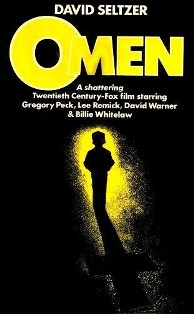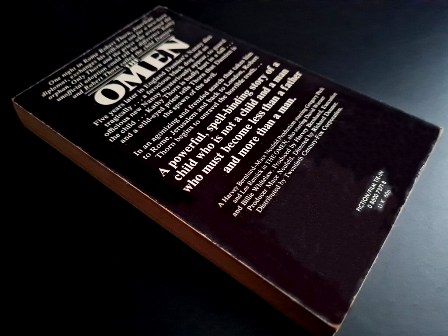
First published back in June of 1976, US screenwriter, producer & director David Seltzer’s novelization of the classic film ‘The Omen’ saw its release just two weeks after the release of the movie, as a cunning marketing ploy. Having written the screenplay for the film, Seltzer made some surprising alterations to the novelization, one of which being with a number of character’s names. Seltzer also fleshed-out many of the characters backgrounds, allowing for a more full-bodied characterization of each.
DLS Synopsis:
On the outskirts of Rome, Katherine (Kathy) Thorn, the wife of wealthy American diplomat Robert Thorn, is giving birth to their first born child. However the child is sadly stillborn. Wishing to spare his wife of the soul-destroying trauma of a dead child, Robert Thorn agrees to a baby swap with that of an orphaned baby who was born that very same night to a mother who he is told died during labour. And so, unbeknown to Katherine Thorn, the switch takes place, and the wealthy couple are handed the healthy newborn baby that was born at precisely 6am on the 6th June.
Back in Fulham, West London, and the Thorn’s child, Damien Thorn, is celebrating his fifth birthday with an extravagant party. However the day turns to tragedy when Damien’s cheerful live-in nanny, Chessa, declares to Damien in front of all of the partygoers that “it’s all for you” before she leaps from the first floor window of the Thorn estate with a rope around her neck.
Freelance photographer, Keith Jennings, is present at the party and had managed to capture a number of photos of the various partygoers before the tragic event of Chessa’s public suicide. Upon having the photographs developed, Jennings finds strange imprints on the photographs showing a blurred marking around the plump young nanny’s neck prior to her hanging. As if it was a strange somehow predicting the nanny’s death.
Meanwhile local vicar, Father Brennan, has discovered what he believes is the truth behind young Damien Thorn. A horrifying revelation for which he immediately attempts to convince Robert about. And so Brennan approaches Robert declaring that Damien is none other than the Anti-Christ, and that before he comes to power he will first kill the unborn child that Katherine is currently carrying and later still Robert himself.
At first Robert Thorn refuses to believe a word of it, but after returning home, he finds out that his wife is indeed pregnant again. However, the joy of the pregnancy is short lived when Damien, together with their new nanny Mrs Baylock, orchestrates an elaborate accident which sees Katherine take a terrible fall over the inner railings of the house. Tragedy befalls the thorns again as they learn that due to the fall, they have lost their unborn child.
An air of doubt slowly begins to enter Robert Thorn’s mind. And when he learns that the vicar, Brennan, was killed in a freak accident when a church spire impales him during a thunderstorm, Thorn suspects that there may actually be some truth to the dead vicar’s ramblings.
And it’s not long before Robert Thorn is approached again regarding Damien, this time by Keith Jennings, after the photographer had pulled together various pieces of evidence that point to Damien being more than just the son of a wealthy diplomat. But it’s only when Thorn and Jennings travel to the hospital in Rome where Damien was born that Robert is finally convinced of Damien’s true calling.
After the two men find that the hospital had burned down shortly after Damien’s birth, they nevertheless manage to obtain the location to the grave of Damien’s true mother. And after exhuming the rotten coffin from the abandoned Etruscan cemetery, they prize open the lid, revealing the skeletal remains of a jackal. Damien’s true mother. The mother of the beast. The Anti-Christ. And he is now among them...
DLS Review:
The first thing that should really be said about Seltzer’s novelisation of ‘The Omen’ is how close it keeps to the film’s screenplay. Indeed, Seltzer barely deviates from any aspects of the events portrayed in the film at all, other than the (somewhat disappointing) alteration of the death sequence for photographer Keith Jennings. Although how well the unforgettable ‘sheet-of-glass-decapitation’ sequence would have translated to paperback may well have been a deciding factor in this surprising deviation from the screenplay.
Like with the film, the novel utilises a monstrous platform of mounting tension, which grows with each new revelation about Damien’s true identity and the frequent accidents that befall anyone who looks to stand in the way of his upbringing. From the outset this impressive level of tension instantly starts to smother the reader, with a bleak atmosphere of oppressive foreboding that sets the tone for the story perfectly.
Even after having seen the film countless times over the years, Seltzer’s novelisation still had me utterly enthralled throughout the length of the tale; with masterfully formed atmosphere and a quivering energy, making it incredibly difficult to put down. Okay, so it’s hard not to picture the likes of Gregory Peck and David Warner in your head whilst reading the tale. But isn’t that what novelizations should be doing? Merely reproducing the film in written format. If this is indeed the case, then hands down to Seltzer, he’s certainly achieved.
It’s hard to say anything particularly critical about the novelisation, because it sticks to the film so rigorously, and manages to successfully portray the characters and the atmospheric evil of the storyline so very perfectly. But still, it doesn’t push any further boundaries for which it is much more capable of doing with the flexibility of the written medium (as opposed to a tight filming budget). Although Seltzer does explore the characters to a much deeper degree; fleshing-out their lives and emotional responses in the face of the unveiling situation, all with admirable gusto.
And so, all in all it must be said that Seltzer’s novelisation is a winner on pretty much all accounts. You can’t fault the writing and the utterly compelling plot. Seltzer has done an outstanding job in reproducing the stark terror of the film, and keeping very true to the constant feeling of a mounting evil. But if anything, Seltzer has perhaps held back just a tad too much when exploring potential new avenues with the story. Not to everyone’s liking in a novelisation I must confess, but if done well, such slight deviation from the original screenplay can prove to make for a more enthralling tale.
The novel was later followed on with Joseph Howard’s sequel ‘Damien: Omen II’ (1978) and then Gordon McGill’s ‘Omen III: The Final Conflict’ (1980), ‘Omen IV: Armageddon 2000’ (1983) and finally ‘Omen V: Abomination’ (1985) .
The novel runs for a total of 192 pages.

© DLS Reviews
Other ‘Omen’ instalments:
- ‘The Omen’ (1976)
- ‘Damien: Omen II’ (1978)
- ‘Omen III: The Final Conflict’ (1980)
- ‘Omen IV: Armageddon 2000’ (1983)
- ‘Omen V: Abomination’ (1985)









